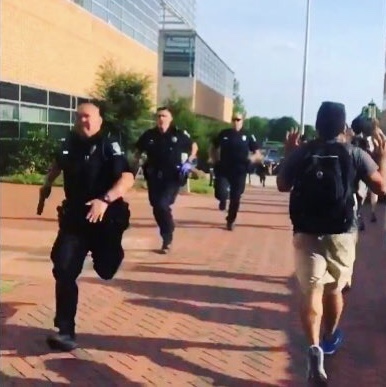
Snapshot of a video captured by Jordan Pearce, a University of North Carolina student, showed people fleeing a campus library as police sprinted toward the area.
On February 15, 2019 officers from the Aurora Police Department in Illinois responded to an active shooter incident at the Henry Pratt Company that left six people dead and six others injured, including five police officers. In the days and weeks that followed, my colleague and friend, Aurora Police Chief Kristen Ziman, spoke often about the importance of police training and stressed that officers, who spend most of their days as “guardians” of the public, must be able to “transform into warriors when the need arises.” I often resist wading into the “police as guardians vs. police as warriors” professional debate. I find it to be at best a false dichotomy and at worst, a divisive argument that separates us from the complexity of our own humanity. That said, the video that flooded social media last week showing University of North Carolina police officers running toward the gunfire as students with hands held high were fleeing to safety arguably resembles images of warriors heading into battle. The truth of the matter is that warriors are guardians and guardians are warriors. These mindsets are not mutually exclusive, in fact they are two sides of the same coin and their currency is safety. And as Chief Ziman noted, “Every day is uneventful until it’s not.” Then what?
It’s the “then what” that necessarily drives the UW-Madison Police Department (UWPD) and police agencies on campuses, in cities, counties, and states across the country to plan, train, prepare and to serve.
In 2018, UWPD employees received a combined total of approximately 9,000 hours of training on topics including but not limited to community relations, emergency management, investigations, lake rescue and safety, leadership, ethics, mental health and wellness, sexual assault, defense and arrest tactics, firearms, professional communications, fair and impartial policing, bias awareness, digital forensics, crisis intervention, de-escalation, and of course, response to active killers. Safety is our trade and the preservation and restoration of peace is our true aim. Tragedies such as the shooting at UNC last week and far too many others like it understandably prompt heightened awareness and concern here at home, and in their aftermath, I often receive questions from many who seek reassurance about our own preparedness. So let me begin by making what I believe is an obvious statement, but one that perhaps, fortunately, most in our campus community take for granted until the uneventful becomes eventful: UWPD doesn’t just focus on campus safety following a tragic incident that garners national attention. UWPD always focuses on safety – 24/7, 365 days a year – it’s what we do and why we are here.
Safety takes many forms and can be ensured through various means. Safety can be the prevention of crime as well as the quick and capable response to crime. Safety is promoted through raising awareness, educating, and empowering our community, as well as through outreach and enforcement initiatives. Safety is experienced physically and mentally and UWPD is dedicated to holistically ensuring both. Most importantly, safety is a shared responsibility and no police department can be successful without the interest, feedback, involvement, and support of our community.
UWPD’s commitment to collaborative approaches to ensuring safety is at the core of everything we do. To this end, we have worked this past academic year with a number of campus/community partners to address specific safety concerns and establish new safety measures:
- In October, we worked with the City of Madison Police Department and students to expand UWPD emergency notifications to include off-campus alerts for our students who live in the Langdon St., lower State St., Gilman St., 600 University Ave. area.
- Throughout the year, we worked with our campus partners who comprise our Threat Intervention Team as well as the Behavior Intervention Team to collaboratively identify, support, and mitigate various safety concerns and earlier this year we embarked on an initiative to improve classroom security with the installation of locking mechanisms in various classrooms across campus.
- This past year we collaborated with campus partners such as the Division of Student Life, University Health Services, Housing, and others to reduce the number of students engaged in high-risk alcohol consumption and provided training to thousands of students and staff through our Active Threat/Killer classes.
- Our UWPD Pride Team was hard at work this past year to address specific policy and training geared to increase safety and further build trust with our LGBTQ+ community.
- Our Emergency Management unit worked across campus to coordinate active killer training, continuity of operations planning, and training exercises/scenarios to bolster our preparedness for critical incidents and emergencies.
- As this semester comes to a close, we have developed a new and improved UWPD Citizen Academy and are in the process of establishing a UWPD Student Safety Council to engage students in ongoing safety efforts such as improved lighting, increased safe transportation options, WiscGuardian and WiscAlert education, blue light phones, and other issues.
These are just a few examples of the ways in which your UWPD is focused on campus and community safety. It has been said that fortune favors the prepared mind and while no police department can train for every single potential scenario, UWPD is committed to doing all that we can to best prepare for the possibility that the uneventful could one day become the eventful.
To everyone: happy spring, enjoy the summer, be safe, and be well. To our graduates: congratulations, well done, and keep Reaching HIGHER!
